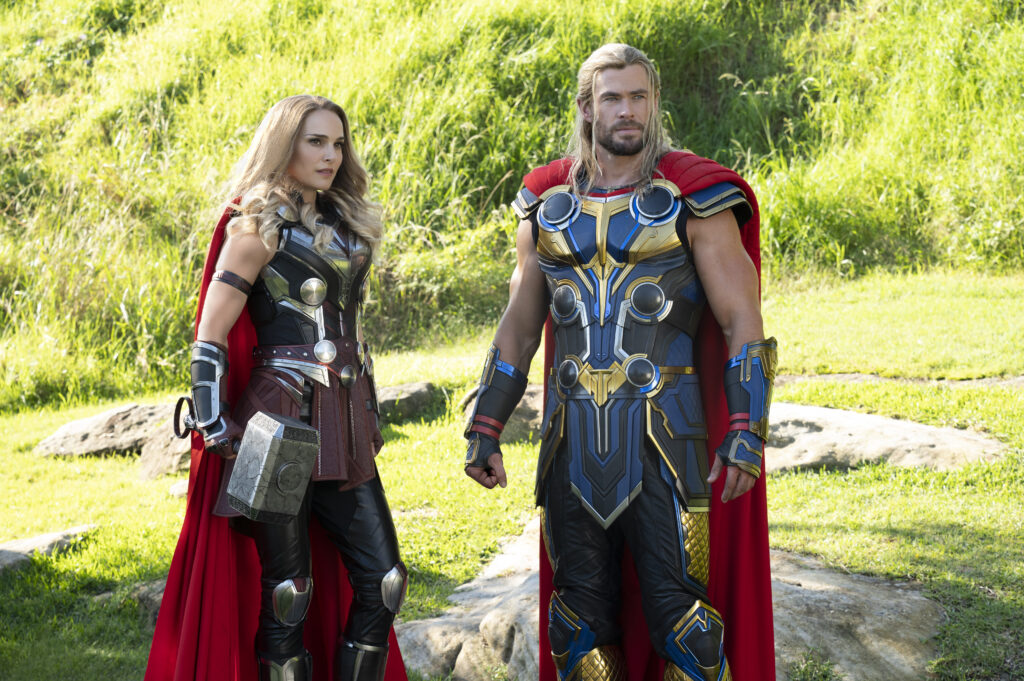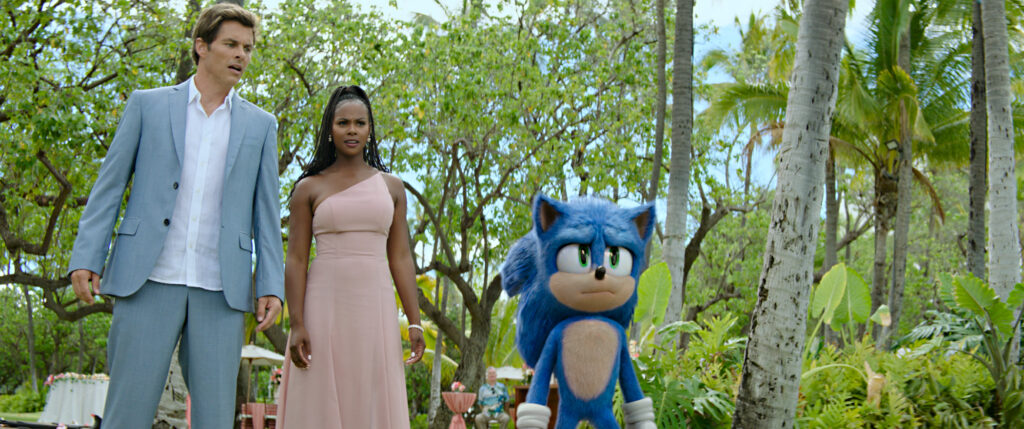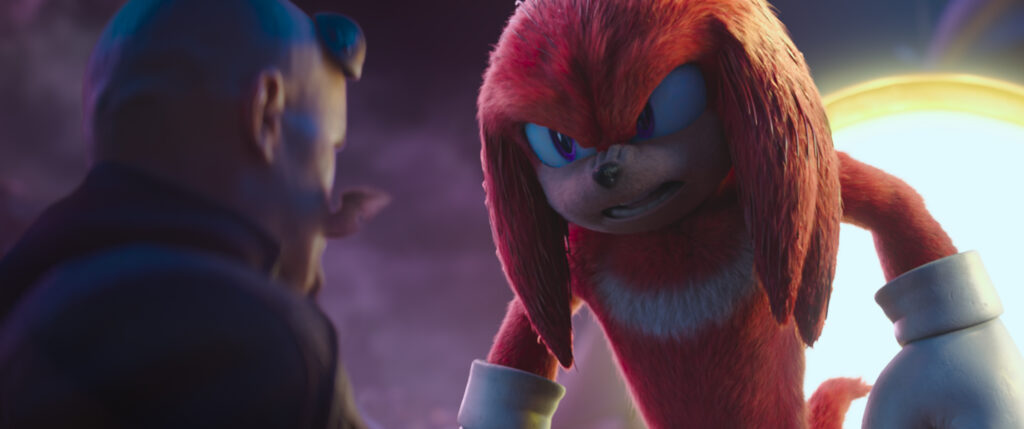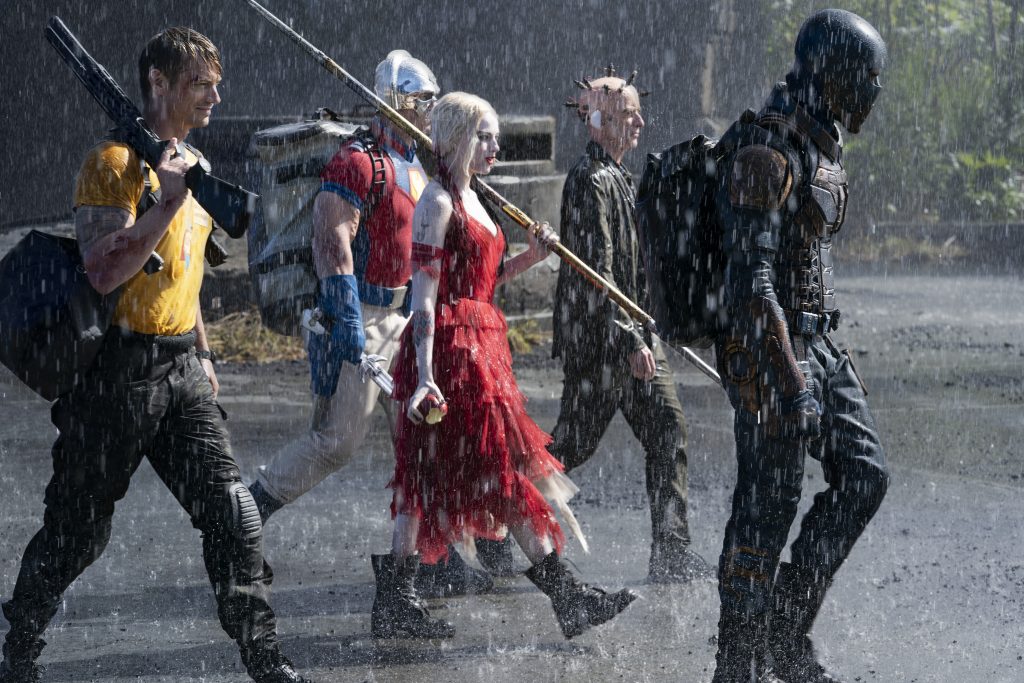August 28, 2022
by Carla Hay

“Three Thousand Years of Longing”
Directed by George Miller
Some language in Hellenic with subtitles
Culture Representation: Taking place in Turkey, the United Kingdom and other parts of the world, the fantasy film “Three Thousand Years of Longing” features a racially diverse cast of characters (white, black, Asian) as human beings and magical beings representing the working-class, middle-class and wealthy.
Culture Clash: A Djinn (also known as a genie) is set free from a bottle by a loner middle-aged divorcée from the United Kingdom, and he tells her stories of how he was trapped inside the bottle at various times over 3,000 years.
Culture Audience: “Three Thousand Years of Longing” will appeal primarily to people who are fans of stars Idris Elba and Tilda Swinton, filmmaker George Miller and adult-oriented fantasy movies.
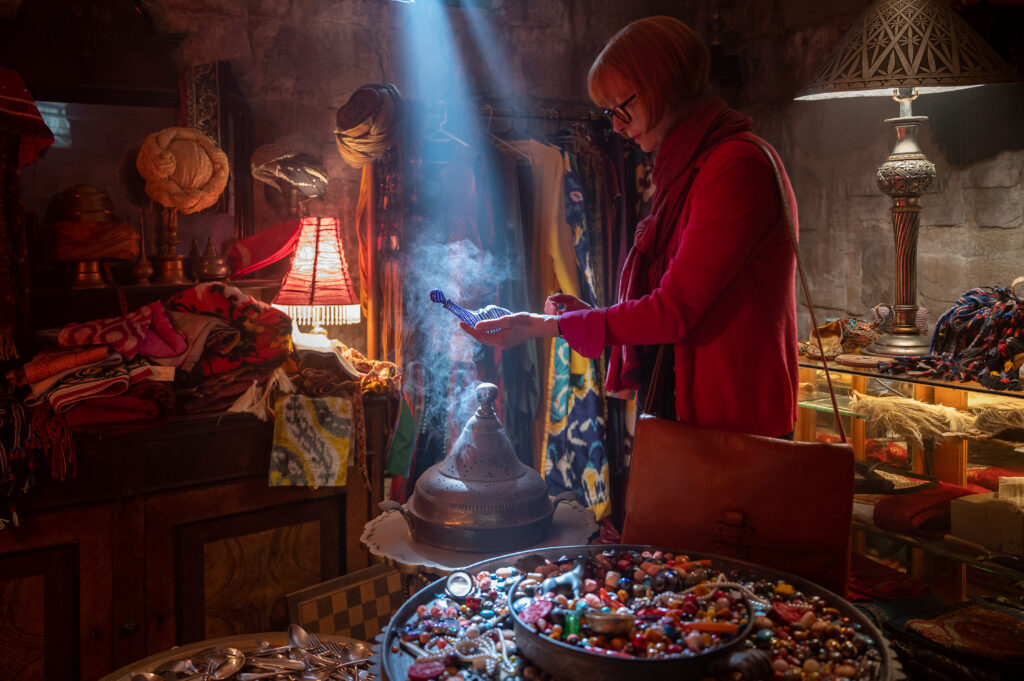
“Three Thousand Years of Longing” is not as weird and edgy as the movie’s trailer would suggest. It’s a sometimes-rambling yet visually striking adult-oriented fairy tale about a genie and the stories he tells to the scholarly divorcée who frees him from a bottle. The film is not a masterpiece, but it’s entertaining enough for people who can engage with a fantasy movie that’s more about storytelling than about fast-paced action scenes.
Directed by George Miller (who co-wrote the movie’s screenplay with Augusta Gore), “Three Thousand Years of Longing” is based on A. S. Byatt’s 1994 novel “The Djinn in the Nightingale’s Eye.” Although the movie is narrated by British scholar Alithea Binnie (played by Tilda Swinton), viewers will learn a lot more about the electromagnetic genie called the Djinn (played by Idris Elba) whom Alithea accidentally releases from a bottle. That’s because almost the entire movie is about the Djinn telling Alithea about three major times in his life that he was imprisoned in a bottle.
In the beginning of the movie, she says in a voiceover: “My name is Alithea. My story is true. You’re more likely to believe me if I tell you it’s a fairy tale.” Swinton is quite good in the role of Alithea, but she’s portrayed many uptight and quirky British women before in other movies, her work in “Three Thousand Years of Longing” is just more of the same, but not as quick-tempered and unhinged as some of her other eccentric characters in other films.
“Three Thousand Years of Longing” opens with Alithea (who lives in London) arriving in Istanbul, Turkey, for a storytelling conference. (“Three Thousand Years of Longing” was actually filmed in Australia, Turkey and the United Kingdom. The movie had its world premiere at the 2022 Cannes Film Festival in Cannes, France.) In addition to being a scholar, Alithea is an enthusiast of fantasy storytelling. Ever since she was a child, she had an active imagination and kept journals of her fantasy writings and illustrations.
A flashback in the movie shows how Alithea at about 10 or 11 years old (played by Alyla Browne) as a social outcast at her all-girls boarding school. During her childhood, Alithea had an imaginary male creature friend named Enzo (played by Abel Bond) that she wrote about and drew in her journals. Alithea could see and hear Enzo but no one else could. Enzo would often comfort her when she was feeling lonely and sad. Don’t expect to find out anything about Alithea’s family, except to know that she has no siblings.
Now in her late 50s or early 60s, Alithea is now a professor of narratology who has been divorced since she was in her 30s. She’s still a loner who writes and draws in journals what comes up in her vivid imagination. Alithea also still sees visions of various magical creatures that look real to her, but no one else can see them.
For example, when she arrives at the airport, she sees a short, odd-looking man who tries to help her carry her suitcase, but she refuses, and he disappears into the crowd. When Alithea tells a male professor colleague (who’s sharing a car ride with her) about this strange experience, she describes the unusual man as “hot to the touch” and “musky.” Alithea’s colleague suggests that she might have seen a ghost.
Alithea is one of the speakers at the conference, where she says that stories about mythical gods have been a part of human hstory for ages. (In the background on the conference stage is a collage portrait of comic book superheroes, to illustrate her point.) During her speech, Alithea sees in the audience a vision of ghost-like elderly man wearing all white in an ancient royal outfit, including a crown.
Suddenly, this mystery spirit lunges at Alithea. And the next thing she knows, she’s being woken up by people on the conference stage because she’s been told that she fainted. Alithea has no memory of passing out. And she insists that she’s feeling perfectly fine.
In her hotel room, Alithea takes out a blue-and-white stripped bottle that looks like a perfume bottle. A brief flashback show that she purchased the bottle at trinket shop in an Instanbul bazaar. The bottle had burn marks on it, but that just makes her more interested in buying. “I like it,” she tells the shop owner. “I’m sure it has an interesting story.”
Alithea takes a toothbrush to try to rub off some of the burn marks. And that’s when the Djinn come out of the bottle, in clouds of purple smoke. At first, the Djinn appears in giant form, but eventually, he shrinks himself down to the form of a human. He begins speaking to her in Hellelnic (a language that Alithea knows), btu then eventually spends the rest oft he time talking to Alithea in her native English language. Alithea is convinced that that the Djinn is part of her imagination, but the more he talks to her, the more she’s convinced that he’s real.
The Djinn essentially says that he’s been trapped in the bottle for nearly 200 years. And in order for him to gain eternal freedom, he tells Alithea that he must grant three wishes to her. There are some caveats to these wishes. She cannot wish for eternal wishes or anything that would end suffering. Her wishes must also be heartfelt and sincere, not taken as a joke, in order for the wishes to really come true.
Alithea insists to the Djinn that she’s perfectly content with her life and doesn’t have any wishes. She has no loved ones and is happy with her job. Alithea only opens up about her her past experiences with love and heartbreak when she briefly tells him about her lonely childhood and her divorce. It’s the only glimpse into Alithea’s personal life.
Alithea was married to her college sweetheart Jack (played by Peter Bertoni, in a flashback scene) for a period of time that appears to be less than 10 years. Alithea and Peter had many things in common, and she thought that they were soul mates. At one point, Alithea got pregnant and was far-enough along in the pregnancy that she knew she was going to have a boy. Alithea and Jack were going to name the child Enzo.
All of this information can be deduced from a brief flash of a pregnancy test vial showing a positive test result. Alithea had kept this pregnancy test vial as a memento in a scrapbook and had written the name Enzo on the vial. When Alithea tells the Djinn about her marriage, she never goes into details about happened to this pregnancy.
However, it’s implied that she had a miscarriage, since the child is never seen in the flashbacks. Alithea says that she and Jack eventually drifted apart (with the implication that the loss of the child was a big reason why), and they got divorced. Jack eventually married a younger woman named Emmaline Porter (played by Lianne Mackessey), and Alithea has seen the happy couple together in London on at least one occasion.
The Djinn has his own stories of loss and heartbreak to tell. His first story of being imprisoned in the bottle is about when he was the servant/lover of Africa’s Queen of Sheba (played by Aamito Lagum), who did not love the Djinn in the way that the Djinn loved her. A love triangle developed when a visiting king named Solomon (played by Nicolas Mouawad) began courting the queen. You can easily guess how this love triangle ended.
The Djinn’s second story of being “incarcerated” in a bottle takes place in the 1530s, during the rule of Turkey’s Ottomon Empire. The story begins with a destitute and enslaved young woman named Ezgi (played Pia Thunderbolt) releasing the Djinn from a bottle. The Djinn grants Ezgi’s wish to marry Prince Mustafa (played by Matteo Bocelli), who is next in line to inherit the kingdom.
However, a power struggle breaks out between Prince Mustafa, his younger brother Ibrahim (played by Jack Braddy) and their father Sultan Suleiman (played by Lachy Hulme). Ibrahim has a sexual fetish for plus-sized women. One of the women in Ibrahim’s harem plays a role in Djinn’s fate.
The Djinn’s third story is supposed to be the most impactful, but it’s the most underdeveloped and seems too rushed in the movie. In this story (which takes place in the mid-19th century in Turkey), the Djinn talks about Zefir (played by Burcu Gölgedar), a woman whom Djinn describes as perhaps the greatest love of his life. The Djinn says that he loved Zefir more than he loved the Queen of Sheba.
At the age of 12 years old, Zefir was forced to marry a Turkish merchant, whose name is not mentioned in the movie. This merchant is old enough to be Zefir’s grandfather. Zefir is the merchant’s third wife in his harem. His other two wives, who are close to the merchant’s age, are very jealous of Zefir and treat her like an outsider. A lonely Zefir eventually finds the bottle where the Djin was kept and frees him.
All three of the Djinn stories involve a woman freeing him from a bottle and some kind of power struggle that ensues. Djinn describes himself in his relationships as loyal and accommodating. And he is that way with Alithea too, but only after she begins to trust him. He can be impatient with Alithea when she’s indecisive about if or when she wants to make a wish.
Because the movie reveals up front that Djinn’s three stories are about how he got trapped in a bottle on three separate occasions, viewers aleady know that each story will not end well for the Djinn. And therefore, the movie’s only real question that needs to be answered is: “What will Ailthea’s wish for, if she chooses to make any or all of the three wishes?”
Alithea thinks that all stories about wishes are “be careful what you wish for” cautionary tales, so she’s afraid of making any wish that could be a big mistake. Through the Djinn’s stories, she starts to understand that life can be a very dull existence if risks aren’t taken. Alithea also learns that it’s not always selfish to ask for what you want.
“Three Thousand Years of Longing” has the look of an ambitious fantasy film, but thankfully is only 108 minutes long. The visual effects and cinematography are well-done, and the acting is perfectly fine from all involved. However, the movie is not without its flaws.
The three stories are unevenly paced to the importance each story has to the Djinn’s life. The second story that takes place during the Ottoman Empire should have been shortened and the time used to expand more on the third story about the Djinn’s relationship with Zefir. There’s not much in the movie to show why Djinn considers his relationship with Zefir to be a great love affair.
Zefir and the Djinn are not shown connecting on any emotional level. The Djinn essentially does what Zefir wants, including making himself disappear, especially when her husband is around. And, as previously mentioned, Alithea remains a bit of a mystery throughout the entire. The only other insight into Alithea’s personal life is when she returns to London and shows disgust for the racial and ethnic bigotry expressed by two nosy, elderly women who live in the house next door.
“Three Thousand Years of Longing” is not going to appeal to people who are expecting any comedic moments. It’s a brooding movie that’s not overly intense or gory, but it’s far from being lighthearted and whimsical. It’s probably one of the most serious-minded gene movies you’ll ever see, Viewers might get some enjoyment out of the acting and the storytelling format of the movie, which has a timeless message about valuing love, no matter where and when someone exists.
United Artists Releasing/Metro Goldwyn Mayer Pictures released “Three Thousand Years of Longing” in U.S. cinemas on August 26, 2022. The movie is set for release in Australia on September 1, 2022.



